Blocks and Pulleys Selection Guide
Sailing Blocks are used for various purposes onboard a yacht or sailboat.
Here is a guide to the different types available and the various uses for sailing blocks.
The term Block (also known as a pulley) refers to a manufactured part incorporating a wheel and an axle, which allows the wheel to rotate.
The wheel has a groove, and the rope or wire sits in the groove. The wheel may also be called a drum but is commonly called a sheave.
The axle is also known as the pin, bush or bearing.
The pulley or block is used to lift or lower heavy objects and facilitate a rope or wire's smooth change in direction.
Onboard a yacht or boat, the pulleys have specific names depending on the task. Blocks have many uses, from simply hoisting flags to managing heavy sails.
Over centuries, new technological developments have advanced the design of sailing blocks to become faster, smoother, stronger, and more dynamic in their specific use, depending on the task.
The main types of blocks are as follows:
The main characteristics of each type of block are explained below.
Plain Bearing Blocks
The plain bearing block, the mainstay of the running rigging on a cruising yacht, is developed from the traditional dead eye, which has no moving parts and originated as a piece of hardwood, e.g. lignum vitae, with carefully grooved holes. Things have gone full circle with the advent of the modern-day low-friction ring equivalent.
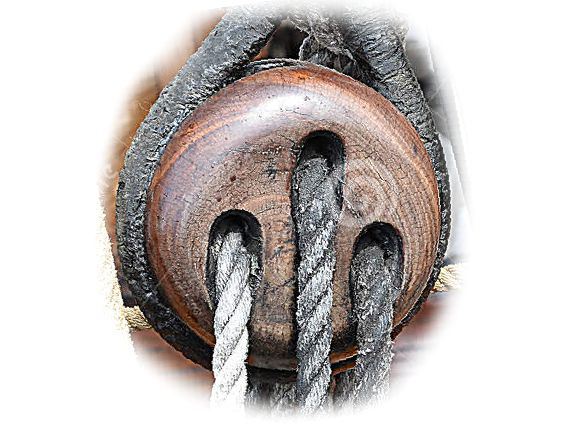
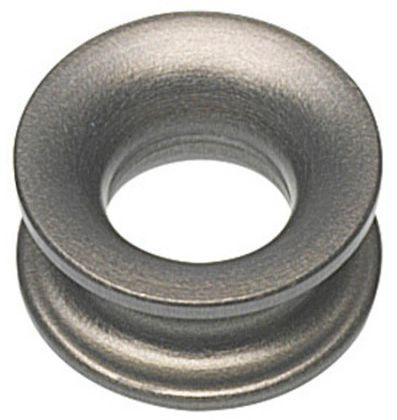
Plain bearing means that the sheave rotates directly on a simple central axle, i.e. the transverse pin between the cheeks of the block.
The sheave (pulley wheel) may have a load-bearing bush, also known as a bushing or sleeve bearing.
The aim of adding a bush is to reduce friction and resultant wear.
The bush that bears the load originates from the term Plain Bearing.
The picture shows a Barton plain bearing block, a sheave with a bush fitted and a sheave with no bush.
Plain bearing block features:
- No ball bearings, no roller bearings!
- Simple construction with only one moving part, the least possible to construct a serviceable pulley.
- Low maintenance
- The sheave rotates directly on a simple axle pin, which may have a load-bearing bush - sheaves have a groove designed to accept rope or wire sympathetically and are machined from nylon, aluminium alloy, brass or similar materials.
- Cost effective - reasonably priced compared with ball bearing or roller bearing blocks.
- Excellent for high static loads
- Excellent all round, multi-purpose functionality
- Excellent working life – no bearings to be crushed or fall out
Ball Bearing Blocks
Blocks with rolling elements are an engineering development of the plain bearing block.
Ball Bearing Blocks are ideal for running rigging applications where the line needs to run fast through the system and where the line needs constant adjustment under load, e.g. racing sheets - "release, pump, tension, release, pump, tension".
Blocks with bearings will run faster under light load and cope much better with fine-tuning adjustment under extreme load.
Ball Bearings in blocks are designed to rotate freely and can be identified by the fantastic whizzing sound they make when spun by hand under no load.
Ball Bearings are a set of multiple, relatively small diameter, spherical balls encapsulated in a ball 'race or cage' between the sheave and the rotating axle.
The inner and outer ball race holds the balls captive and allows them to roll so freely that they are as close as possible to frictionless.
The hardened, round surfaces of the spherical balls can handle both radial and thrust loads.
The minimal contact surface area between the small spherical balls is the reason for their negligible resistance to movement.
However, because the load-bearing surface is also low, ball bearings are susceptible to distortion when subjected to heavy force.
The picture shows a Harken ball bearing block, a ball bearing and a Selden ball bearing block.
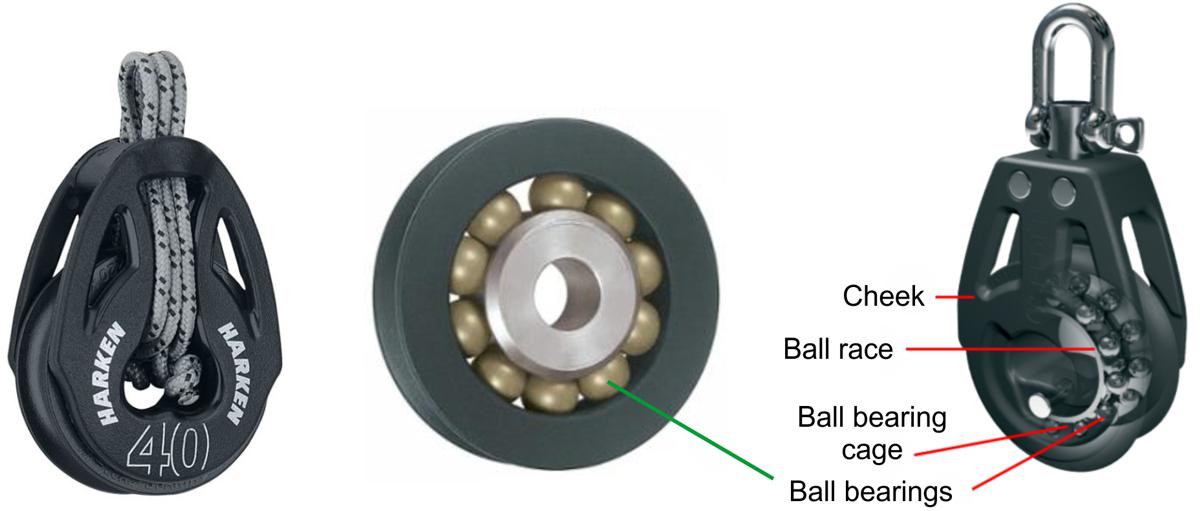
Ball bearing block features:
- Virtually frictionless sheave rotation for free-running lines
- Outstanding response under dynamic loads
- Ultimate performance and functionality for racing
- Suitable for rapid release and continual tuning
- Excellent durability with Delrin/Torlon ball bearings
Roller Bearing Blocks
Blocks with rolling elements are an engineering development of the plain bearing block.
Roller Bearing Blocks are the 'Rolls Royce' premium choice for high load-bearing capability and low resistance under dynamic load.
Go for roller bearings if you want exceptional performance for Racing, Regatta or Performance Cruising, especially for applications where it may be necessary to release or adjust a control line under extreme tension.
Prompt, safe and efficient manoeuvers can be more easily achieved if the control line can be fine-tuned or released under pressure, e.g. your running backstay/vang/kicker purchase, main sheet or spinnaker halyard.
Roller Bearings are a succession of small diameter tubes or cylinders fitted into a roller 'race or cage' between the sheave and the axle.
Roller bearings have more surface area contact than ball bearings.
The increased surface area increases the load capacity and distributes it more evenly so that roller-bearing blocks generally have a much higher resistance to distortion under load than ball-bearing blocks.
Roller bearings run less freely than ball bearings but have exceptionally low friction.
The picture shows a roller bearing on a sheave, an exploded diagram of a Harken roller bearing block, and another roller bearing design.

Roller bearing block features:
- Ultimate dynamic load capacity
- Premium Choice for severe conditions
- Excellent effectiveness under extreme static loads
- Outstanding response under acute dynamic loads
- Ultimate all-round, multi-purpose, high-performance functionality for Regatta sailing
- Excellent durability with Torlon roller bearings
Rachet Blocks
Ratchet Blocks are ball-bearing blocks with an extra built-in braking mechanism.
The sheave is designed to grip the line and allow the brake to take the load. The braking feature is a ratchet system which stops the sheave from rotating.
The sheave design on a ratchet block differs from the smooth, rounded finish on a standard plain or roller-bearing block. Ratchet sheaves are typically designed with eight-sided facets (they look a little bit like shallow gypsy wheel pockets). These facets (flat angled surfaces) grip the line when the ratchet is working under load.
The ratchet works like a socket wrench or the internal workings of a sheet winch. There are ratchet pawls which drop into teeth as the sheave rotates. This is what makes the distinctive clicking noise. When rotation is ceased, the ratchet pawl engages the aligned tooth and holds a share of the load, using the friction created between the rope and the faceted sheave.
Ratchet blocks make it easier for your crew to haul in, manually hold and adjust lines, which would otherwise be impossible to physically manage under load. They also allow lines cleated under extreme tension to be eased without jumping out and ripping through your hands as soon as the jammer is released.
On dinghies, dayboats and small yachts, ratchet blocks counteract the need for jamming cleats on jib, spinnaker and mainsheets. However, a jammer may still be necessary to free your hands, for, e.g. adjusting control lines or giving your fingers a much-needed rest!
On larger yachts, they offer extra control for trimming the spinnaker on a winch.
Ratchet Blocks are available in two distinct variations:
- Manual Ratchet Blocks feature a switch for on/off engagement - When the ratchet is on, the sheave will only operate in one direction to pull the line in. The ratchet mechanism that takes the load prevents any rotation in the other direction, which means that when the line is eased, it will have to run around a static crenellated sheave.
- Automatic Ratchet Blocks are fitted with an automatic tension sensing mechanism, which engages at a pre-set load and automatically releases when the line is eased. The roller bearings run freely in both directions under low loads and automatically engage as the pressure increases. Shifting between heavy and light loads is intuitive and seamless.
The Automatic version can change from ratchet assisted, e.g. upwind jib and main, downwind spinnaker in moderate and stronger breezes, to free spinning, e.g. easing sheets during mark rounding, tacking and gybing. The pressure required to induce the auto ratchet mechanism can be adjusted according to the strength of both the crew and the breeze using an Allen key.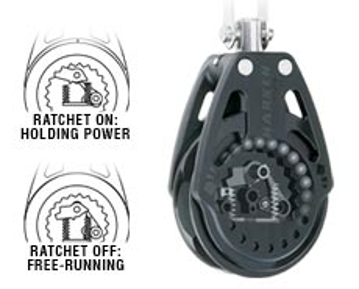
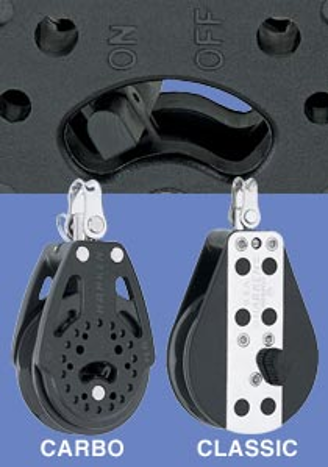
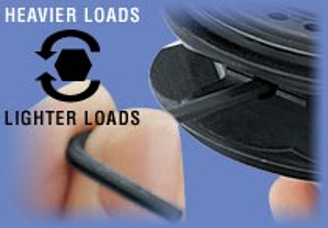
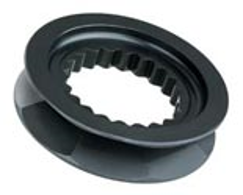
Ratchet blocks are, in effect, a miniature version of a winch without a winch handle (also known as a snubber), which can perform a similar function within the limits presented by a much smaller surface area due to the narrower diameter.
Some class rules outlaw any mechanical advantage for pulling in the sheets, which prevent the use of winches, e.g. Beer Luggers, where there is a great onus on ratchet blocks and snubbers to enable the crew to haul in, hold and control a loose-footed mainsail of around 300 square feet by hand. Ratchet blocks require less effort to control the sail than a normal free-running block.

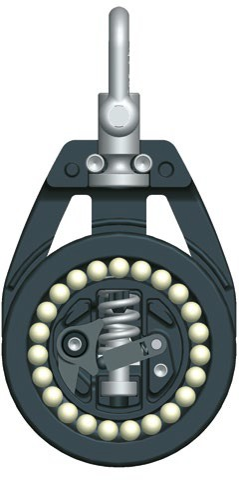
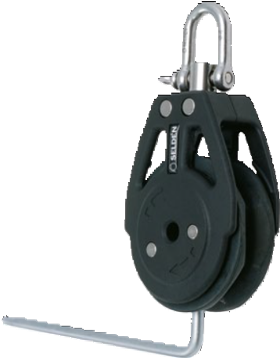
Ratchet blocks are generally suitable for sheets on boats up to and including 6-metre sports boats and on larger boats in tandem with a winch with some caveats (these are not exhaustive):
- Mainsheet systems must be attached to the boom in multiple spots near the stern end (away from the gooseneck) to reduce/spread the load.
- Spinnaker sheets require a winch back-up option if the breeze gets up.
- Jibs and Genoas generally don’t need ratchets. The shorter sheet lengths mean the sail can usually be secured in a cleat or around a winch before it becomes fully loaded
- Ratchet blocks can be mounted in series so that spinnaker sheets on, e.g. Sports Boats like the Melges and J24s, can be hand trimmed in all conditions. The holding power can be fine-tuned by engaging/disengaging the ratchets to match the breeze strength.
Line Diameter and Specification – Important Factors:
Match the size of the block (sheave diameter) to the required load; see illustration below: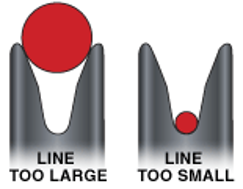
Select the correct diameter line for the block because only a correctly matched diameter line will grip effectively in the flat facets on the sheave.
Select the appropriate rope finish - ropes with a smooth, hard feel will not hold as effectively as those with a more supple, pliable construction.
Select a line that will withstand the massive wear and tear increase caused by continuous adjustment on the faceted sheave.
This means a regatta performance line is normally required, preferably with Dyneema or Technora blended with polypropylene (lighter weight) or polyester (heavy duty).
Snatch Blocks
Snatch Blocks are an extremely useful addition to the rigging spares inventory on any sailing yacht because they can quickly and efficiently provide a temporary solution to various line routing issues.
Jimmy Green offers various options from leading block manufacturers: Holt, Allen, Lewmar, Harken and Wichard.
What is a Snatch Block?
A snatch block is a single sheave pulley where one of the side cheeks/straps opens to allow a rope to be inserted, without the rigmarole of reeving the line through the entire system.
The opening function is achieved in varying designs by different manufacturers, but the purpose remains the same, e.g.
- Holt, Allen, Lewmar and Wichard - hinged head located on the sheave pin
- Harken and Wichard - soft attachment, removable on one side
Soft blocks perform a similar function to snatch blocks - made from a horseshoe shape fairlead - effectively an open-ended low friction ring - with a Dyneema loop which can be attached and detached.
Snatch Block Facts, Features and Plus Factors:
- The extra design and manufacturing process makes snatch blocks much more expensive than standard design blocks.
- The opening design allows a rope to be inserted without any reeving required - especially helpful if the line is long and it passes through multiple leads and clutches.
- Open the block, insert the line, close the block securely and attach the head of the block to your intended strongpoint.
- Quick and effective solution for changing sheet or control line leads.
- Excellent as temporary or spinnaker sheet-turning blocks.
- Can also be easily employed to create a 2:1 purchase, doubling the pulling power.
- Jimmy Green offers various options from leading block manufacturers: Holt, Allen, Lewmar, Harken and Wichard.
Visit our Deck Hardware category to explore the range of blocks available.













